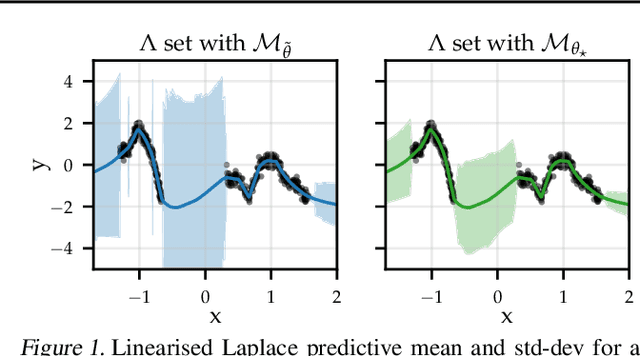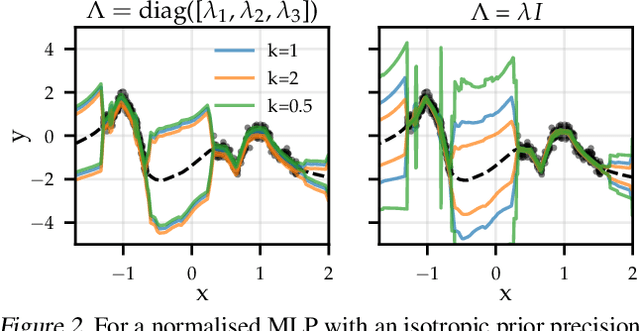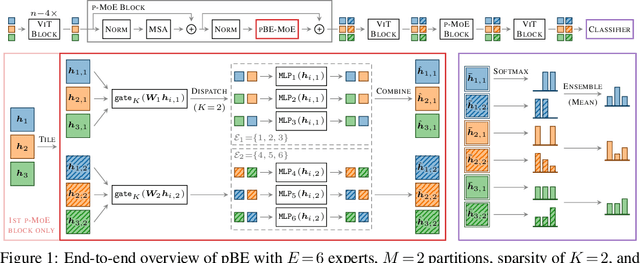James Urquhart Allingham
A Generative Model of Symmetry Transformations
Mar 04, 2024Abstract:Correctly capturing the symmetry transformations of data can lead to efficient models with strong generalization capabilities, though methods incorporating symmetries often require prior knowledge. While recent advancements have been made in learning those symmetries directly from the dataset, most of this work has focused on the discriminative setting. In this paper, we construct a generative model that explicitly aims to capture symmetries in the data, resulting in a model that learns which symmetries are present in an interpretable way. We provide a simple algorithm for efficiently learning our generative model and demonstrate its ability to capture symmetries under affine and color transformations. Combining our symmetry model with existing generative models results in higher marginal test-log-likelihoods and robustness to data sparsification.
Towards Anytime Classification in Early-Exit Architectures by Enforcing Conditional Monotonicity
Jun 05, 2023Abstract:Modern predictive models are often deployed to environments in which computational budgets are dynamic. Anytime algorithms are well-suited to such environments as, at any point during computation, they can output a prediction whose quality is a function of computation time. Early-exit neural networks have garnered attention in the context of anytime computation due to their capability to provide intermediate predictions at various stages throughout the network. However, we demonstrate that current early-exit networks are not directly applicable to anytime settings, as the quality of predictions for individual data points is not guaranteed to improve with longer computation. To address this shortcoming, we propose an elegant post-hoc modification, based on the Product-of-Experts, that encourages an early-exit network to become gradually confident. This gives our deep models the property of conditional monotonicity in the prediction quality -- an essential stepping stone towards truly anytime predictive modeling using early-exit architectures. Our empirical results on standard image-classification tasks demonstrate that such behaviors can be achieved while preserving competitive accuracy on average.
A Simple Zero-shot Prompt Weighting Technique to Improve Prompt Ensembling in Text-Image Models
Feb 13, 2023



Abstract:Contrastively trained text-image models have the remarkable ability to perform zero-shot classification, that is, classifying previously unseen images into categories that the model has never been explicitly trained to identify. However, these zero-shot classifiers need prompt engineering to achieve high accuracy. Prompt engineering typically requires hand-crafting a set of prompts for individual downstream tasks. In this work, we aim to automate this prompt engineering and improve zero-shot accuracy through prompt ensembling. In particular, we ask "Given a large pool of prompts, can we automatically score the prompts and ensemble those that are most suitable for a particular downstream dataset, without needing access to labeled validation data?". We demonstrate that this is possible. In doing so, we identify several pathologies in a naive prompt scoring method where the score can be easily overconfident due to biases in pre-training and test data, and we propose a novel prompt scoring method that corrects for the biases. Using our proposed scoring method to create a weighted average prompt ensemble, our method outperforms equal average ensemble, as well as hand-crafted prompts, on ImageNet, 4 of its variants, and 11 fine-grained classification benchmarks, all while being fully automatic, optimization-free, and not requiring access to labeled validation data.
Adapting the Linearised Laplace Model Evidence for Modern Deep Learning
Jun 17, 2022



Abstract:The linearised Laplace method for estimating model uncertainty has received renewed attention in the Bayesian deep learning community. The method provides reliable error bars and admits a closed-form expression for the model evidence, allowing for scalable selection of model hyperparameters. In this work, we examine the assumptions behind this method, particularly in conjunction with model selection. We show that these interact poorly with some now-standard tools of deep learning--stochastic approximation methods and normalisation layers--and make recommendations for how to better adapt this classic method to the modern setting. We provide theoretical support for our recommendations and validate them empirically on MLPs, classic CNNs, residual networks with and without normalisation layers, generative autoencoders and transformers.
Sparse MoEs meet Efficient Ensembles
Oct 07, 2021



Abstract:Machine learning models based on the aggregated outputs of submodels, either at the activation or prediction levels, lead to strong performance. We study the interplay of two popular classes of such models: ensembles of neural networks and sparse mixture of experts (sparse MoEs). First, we show that these two approaches have complementary features whose combination is beneficial. Then, we present partitioned batch ensembles, an efficient ensemble of sparse MoEs that takes the best of both classes of models. Extensive experiments on fine-tuned vision transformers demonstrate the accuracy, log-likelihood, few-shot learning, robustness, and uncertainty calibration improvements of our approach over several challenging baselines. Partitioned batch ensembles not only scale to models with up to 2.7B parameters, but also provide larger performance gains for larger models.
Expressive yet Tractable Bayesian Deep Learning via Subnetwork Inference
Oct 28, 2020



Abstract:The Bayesian paradigm has the potential to solve some of the core issues in modern deep learning, such as poor calibration, data inefficiency, and catastrophic forgetting. However, scaling Bayesian inference to the high-dimensional parameter spaces of deep neural networks requires restrictive approximations. In this paper, we propose performing inference over only a small subset of the model parameters while keeping all others as point estimates. This enables us to use expressive posterior approximations that would otherwise be intractable for the full model. In particular, we develop a practical and scalable Bayesian deep learning method that first trains a point estimate, and then infers a full covariance Gaussian posterior approximation over a subnetwork. We propose a subnetwork selection procedure which aims to optimally preserve posterior uncertainty. We empirically demonstrate the effectiveness of our approach compared to point-estimated networks and methods that use less expressive posterior approximations over the full network.
Depth Uncertainty in Neural Networks
Jun 15, 2020



Abstract:Existing methods for estimating uncertainty in deep learning tend to require multiple forward passes, making them unsuitable for applications where computational resources are limited. To solve this, we perform probabilistic reasoning over the depth of neural networks. Different depths correspond to subnetworks which share weights and whose predictions are combined via marginalisation, yielding model uncertainty. By exploiting the sequential structure of feed-forward networks, we are able to both evaluate our training objective and make predictions with a single forward pass. We validate our approach on real-world regression and image classification tasks. Our approach provides uncertainty calibration, robustness to dataset shift, and accuracies competitive with more computationally expensive baselines.
Variational Depth Search in ResNets
Feb 27, 2020



Abstract:One-shot neural architecture search allows joint learning of weights and network architecture, reducing computational cost. We limit our search space to the depth of residual networks and formulate an analytically tractable variational objective that allows for obtaining an unbiased approximate posterior over depths in one-shot. We propose a heuristic to prune our networks based on this distribution. We compare our proposed method against manual search over network depths on the MNIST, Fashion-MNIST, SVHN datasets. We find that pruned networks do not incur a loss in predictive performance, obtaining accuracies competitive with unpruned networks. Marginalising over depth allows us to obtain better-calibrated test-time uncertainty estimates than regular networks, in a single forward pass.
 Add to Chrome
Add to Chrome Add to Firefox
Add to Firefox Add to Edge
Add to Edge